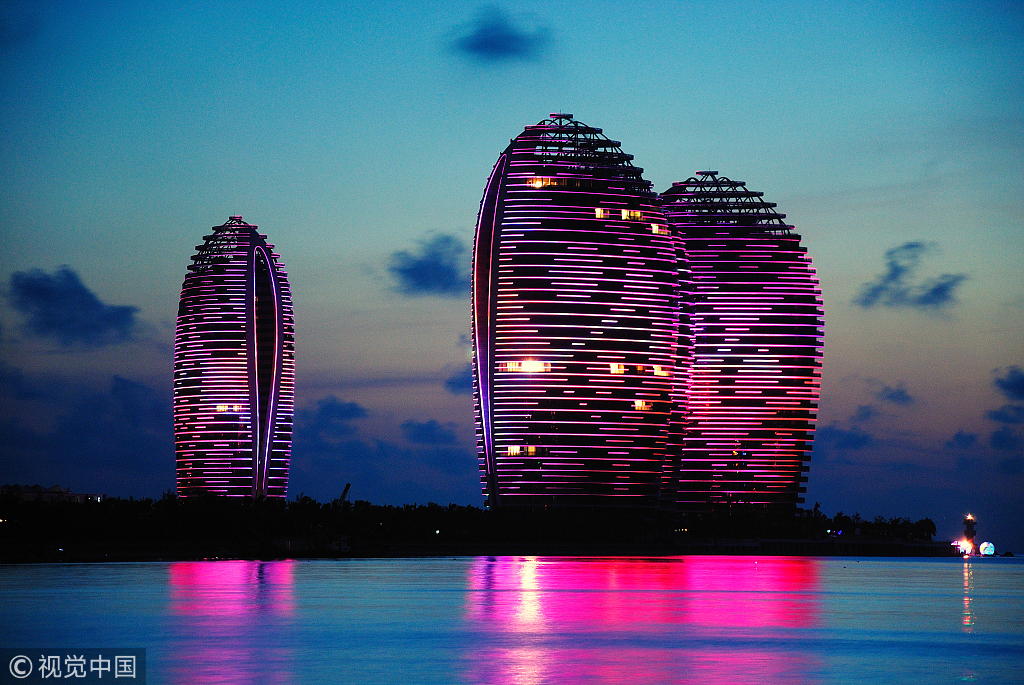
Nightview of Sanya bay in Hainan province. [Photo/VCG]
Offshore duty-free shops in Hainan sold goods worth 5.25 billion yuan ($768 million) during the first six months of this year, up 24 percent from the same period a year ago, according to data from the local customs authorities.
The two duty-free shops in the island, one in the provincial capital of Haikou and the other in the resort city of Sanya, received 1.47 million customers and sold more than 7 million items in the first half.
The State Council gave Hainan permission to conduct a trial offshore duty-free program on April 20, 2011, to help develop the island into a world-class tourist destination by 2020.
Without any restrictions on the number of purchases, non-Hainan residents are allowed to buy duty-free products worth up to 16,000 yuan each year before they leave the island by flight or train.
Travelers can also order online and pick up their purchases at the Haikou Meilan International Airport, the Sanya Phoenix International Airport or the Haikou Railway Station.
In April, the province announced that it plans to establish another offshore duty-free shop in Boao, a town in the city of Qionghai that has conducted the annual Boao Forum for Asia for the past 17 years.
As a leader of Hainan's modern service industry, the tourism industry is upgrading in an all-round way in line with the new positioning by the central authorities, which defines Hainan as an international tourism consumption center.
"This is a big step forward from the former target of building an international shopping destination. It has a higher goal and richer connotation," said Wang Yiwu, president of Hainan Research Institute of Modern Management at Hainan University.
Duty-free shopping was regarded as one of the most valuable and influential policies for Hainan in developing as an international tourist destination. Since April 20, 2011, the ceiling for duty-free shopping has been adjusted four times, from 5,000 yuan to the current quota of 16,000 yuan per tourist. The choices of duty-free goods products have increased from 21 to 38 categories.
"There is still a lot of room for adjustment. For instance, the 16,000 yuan limit is low," Wang said.
In April, the State Council, China's cabinet, released a set of measures on supporting comprehensive in-depth reform and opening up in Hainan. The new measures clearly pointed out that it will introduce a more open and convenient offshore duty-free shopping policy that will benefit all tourists and the quota for shopping will be expanded.
"The quota may be doubled from the current amount and the local authorities are still working on the project," said an official with the provincial government.
Wang believes that raising ceiling for duty-free shopping will attract Chinese tourists who tend to go shopping overseas and boost duty-free sales in Hainan.
The central authorities have also adjusted the visa-free policy for inbound tourism in Hainan to 59 countries from 26 countries since May 1. Hainan's inbound tourists exceeded 1 million for the first time in 2017, reaching 1.1194 million, an increase of 49.5 percent year-on-year, according to data from Hainan provincial tourism commission. This year, Hainan plans to attract more than 1.3 million overseas tourists.
In 2016, China's consumption of luxury goods was 537.3 billion yuan and sales of duty-free goods amounted to 26.3 billion yuan, accounting for only 4.9 percent of the total annual sales of goods in the country, according to a report from the China Industry Information Network.
It said the proportion of sales of luxury goods and duty-free items among China's total sales of commodities was expected to grow to 6.5 percent in 2020, driven by consumption upgrading and policy guidance. Consumption of luxury goods is likely to hit 781.2 billion yuan in 2020 while duty-free sales is estimated to reach 50.7 billion yuan, meaning an annual increase of 18 percent from 2016.
Xinhua contributed to this story.